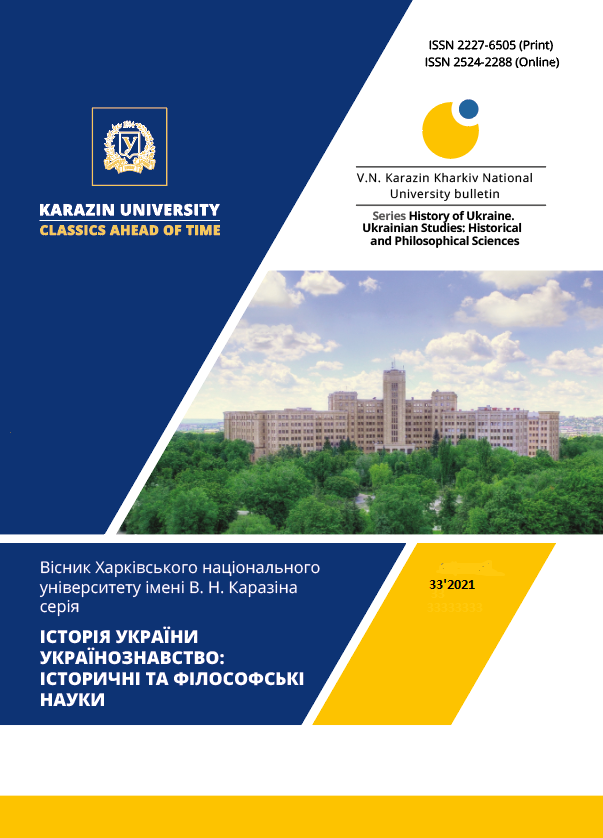State regulation of land relations in the Kuban Cossack army in the middle of the 19th – at the beginning of the 20th century
Abstract
Research aim. The article aims to investigate the measures of the government of the Russian Empire in the field of land relations in the Kuban region, which were aimed at the elimination of the traditional Cossack land system for the natives of the Zaporizhian Military Region.
Research methodology. After the peasant reform of 1861, the state's attack on the traditional Cossack land structure intensified significantly. The scientific hypothesis that in fact the process of "decolonization" in the Kuban was determined by this policy and began as early as the middle of the 19th century was confirmed. In fact, the Russian government pursued a policy of successive liquidation of the land privileges of the Cossacks. As a result, sharp contradictions were constantly growing in the field of land relations, which split the Cossack community into antagonistic social groups.
Scientific novelty.For the first time in Ukrainian historiography, the main steps of the government of the Russian Empire in the field of land relations regulation in the Kuban region in the second half of the 19th - at the beginning of the 20th century were considered. It is shown that this policy was aimed at the gradual systematic liquidation of the traditional Cossack land system for the natives of the Zaporozhye Military Region as the collective land property of the Cossack army.
Conclusions. In the period under review, the policy of the tsarist government of Russia in the field of land relations in the Kuban was actually aimed at eliminating the land privileges of the Cossacks, which were the basis of the Cossack way of life and supported the relative social stability of the Cossack community. In fact, it can be defined as "telling". The reforms of the 1860s and 1870s brought the Cossacks on an equal footing with the civilian population in matters of land use. At the same time, public land funds were reduced, the allotments of ordinary Cossacks decreased, which led to the deterioration of the economic base of the Cossack army.
Against the background of the rapid concentration of land resources in the ownership of the upper layer of the non-urban rural bourgeoisie, the majority of the Cossacks never received land as private ownership and continued to use it as communal members. And although the Kuban Cossacks' relatively good supply of land allowed most of them to remain above the poverty line at the time, state policy in the field of land relations contributed to the rapid accumulation of sharp contradictions that split the Cossack community into antagonistic social groups.
The results of this split clearly manifested themselves during the civil war in Russia, when most of the ordinary Cossacks did not support either the tsarist government, the White Movement, or the attempts of the Kuban Cossack leadership to create an independent Kuban Cossack Republic based on traditional Cossack law.
Downloads
References
Бентковский И. Положение о заселении предгорий Западной части Кавказского хребта. Кубанский календарь. Екатеринодар, 1900. С.17-20.
Лукомец М.И. Землевладение и землепользование на Кубани (1792–1925). Краснодар, 1992. 299 с.
Отчет начальника Кубанской области и наказного атамана Кубанского казачьего войска за 1915 год. Екатеринодар, 1916. 312 с.
Полное собрание законов Российской империи. 2-е изд. Т. 44. № 47847.URL: http://nlr.ru/e-res/law_r/search.php?regim=4&page=412&part=913
Ратушняк В.Н. Земледелие и землепользование. Очерки истории Кубани с древнейших времен до 1920 г. Краснодар, 1996. 353 с.
Чернопицкий П.Г. Деревня Северокавказского края в 1920–1929 гг. Ростов-на-Дону, 1987. 232 с.
Щербина Ф.А. История земельной собственности у казаков. Кубанский сборник. Т. 1. Екатеринодар, 1883. С.88-123.
Державний архів Російської Федерації (ДАРФ), Ф. 252.
References
Bentkovskiy I. Polozheniye o zaselenii predgoriy Zapadnoy chasti Kavkazskogo khrebta [Provision on the settlement of the foothills of the Western part of the Caucasian ridge]. Kubanskiy kalendar'. Yekaterinodar, 1900.S.17-29. (in Russian).
Lukomets M.I. Zemlevladeniye i zemlepol'zovaniye na Kubani (1792–1925). [Land tenure and land use in the Kuban (1792-1925)]. Krasnodar, 1992. 299 s. (in Russian).
Otchet nachal'nika Kubanskoy oblasti i nakaznogo atamana Kubanskogo kazach'yego voyska za 1915 god. [Report of the head of the Kuban region and the orderly chieftain of the Kuban Cossack army for 1915.]. Yekaterinodar, 1916. 312s. (in Russian).
Polnoye sobraniye zakonov Rossiyskoy imperii. 2-ye izd. T. 44. № 47847. [Complete collection of laws of the Russian Empire. 2nd ed. T. 44. No. 47847.]. URL http://nlr.ru/e-res/law_r/search.php?regim=4&page=412&part=913. (in Russian).
Ratushnyak V.N. Zemledeliye i zemlepol'zovaniye. [Agriculture and land use]. Ocherki istorii Kubani s drevneyshikh vremen do 1920 g. Krasnodar, 1996. 353s. (in Russian).
Chernopitskiy P.G.Derevnya Severokavkazskogo kraya v 1920–1929 gg. [Village of the North Caucasus region in 1920-1929.]. Rostov-na-Donu, 1987. 232 s. (in Russian).
Shcherbina F.A. Istoriya zemel'noy sobstvennosti u kazakov. [The history of land ownership among the Cossacks]. Kubanskiy sbornik. T. 1.Ekaterinodar,1883.S. 88-123. (in Russian).
Derzhavnyy arkhiv Rosiysʹkoyi Federatsiyi [State Archives of the Russian Federation], F. 252.




